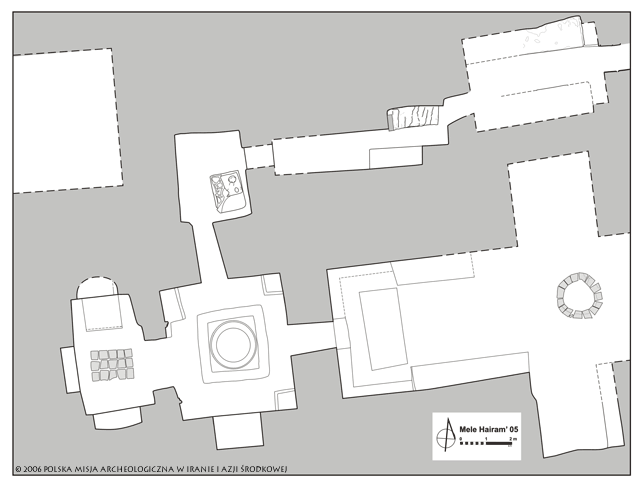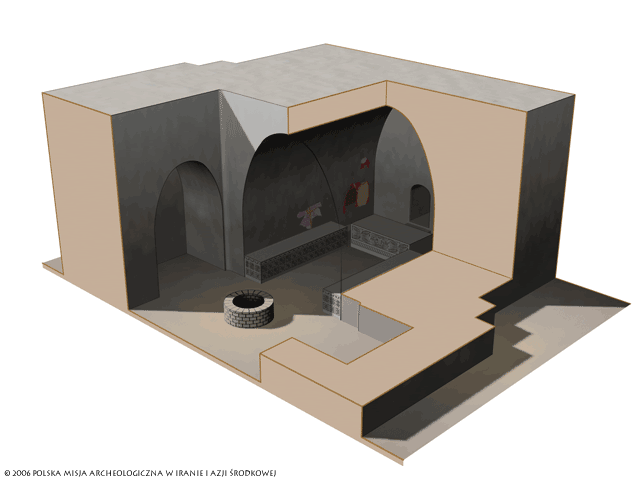Mele Hairam
Archaeological investigations at Mele Hairam have been conducted since 1997 in co-operation with the Turkmen State Magtymguly University in Ashkhabad and the Department of Study, Preservation and Restoration of the Ministry of Culture of Turkmenistan. Although Mele Hairam is just one of the dozens of small sites scattered throughout the Sarakhs oasis in south-western Turkmenistan, it may be safely deemed to be of the highest importance as far as the study of the temple cult of fire in the Parthian and Sasanian times (3rd century B.C. - 7th century A.D.) is concerned.
The fire temple identified at the site represents the fifth as yet known structure of this type that has been subject to profound archeological research. The following are included in this group: Kuh-e Khwaja built probably during the Parthian period, the Sasanian royal fire temple at Tacht-e Suleiman, the Sasanian temple at Hajiabad and the temple at Tureng Tepe dated to the eight century AD.
Although made of sun-dried brick, the Mele Heiram temple walls have survived in an excellent condition with walls reaching up to 3.5 meters in height. A number of archaeological campaigns resulted in most of the temple's architectural concept being revealed.
The temple was accessed from the east, through the entrance passage leading to a small courtyard with a well located in the center. The courtyard preceded the largest chamber of the temple were worshippers used to gather during Zoroastrian feasts to participate in the fire cult ceremonies after having washed themselves in water drawn from the temple well. In the western part of the chamber mural paintings have been chanced upon on the northern and southern walls. Close examination of the murals has revealed these were once depictions of human figures, all white plastered in the last occupational phase of the temple.Similar murals, these depicting decorative designs in medallions, once decorated a vaulted roof of the chamber.
At the rear of the chamber, across an entrance leading to the temple sanctuary, a rectangular clay table-like platform (L=3.08; H=0.88 m) has been excavated covered with a thick layer of gypsum. At least one side of the platform must have been once heavily embellished with relief decorations comprising floral designs combined with three knots filled with pearl motifs. The knots might have served as symbols of three principles of Zoroastrian faith, these being good reflection, good word and good deed.
Running along the walls there have been two clay benches identified, each ornamented with a series of square panneaux filled with palmettes and leafy stems. All together, these three structures seem to have considerably limited the access to the sanctuary. Moreover, they turned out to be a significant element that contributed largely to the establishment of the temple chronology. When compared with similar decorative structures known from other sites, they permitted to date the last phase of the temple occupation to the fifth century A.D.
The sanctuary is a square which measures 5 m on each side. In contrast to other chambers once vaulted, the sanctuary must have been domed. Its central element was a fire altar set inside a square brick enclosure. As suggested by its lowermost preserved part, the altar must have looked much like an hour glass shape. It was presumably topped with a clay slab covered with a gypsum layer. The total estimated height of the altar slightly exceeded one meter (base diam. = 1.46 m). A large niche (1.80 x 1.64 x 1.20 m) in the southern wall, accompanied by a small opening that must have once housed an oil lamp, constitutes a second characteristic feature of the sanctuary. Here, zoatar might have been sitting at his prayers, while raspi was feeding the fire. Of interest are also three of four small platforms once constructed in each corner of the sanctuary. They might have served as shelves for utensils used in religious rituals and ceremonies. The sanctuary had no window openings, it was thus pluged into darkness illuminated only by light of the oil lamp and fire burning on the altar.
Apart from the main entrance, there are two passages in the sanctuary, one leading to the west and one to the north. The western chamber (ca. 4.5 x 2.6 m) played a role of yazisn-gah, i.e. a place where, beside other activities, rituals not directly connected with the fire cult were performed. There are shallow niches cut in the southern and western walls of the chamber. A considerably deeper niche is situated in the northern wall, furnished with a rectangular clay platform (1.34 x 1.20 x 0.70 m). The platform is plastered and shows the remains of a hearth. In the middle of the floor area, there have been fifteen trapezoidal bricks revealed arranged in three rows. They might have been meant for bowls or jars as suggested by their oval hollows.
In the northern wall of the sanctuary there is a passage leading to another rectangular room (ca. 3.40 x 2.85 m). Here, in the south-eastern corner, a high clay platform housing a clay furnace was installed. Large quantities and white color of ash prove that fire was burning long and slowly. The exact function of the chamber remains, however, obscure.
This chamber communicated with the eastern part of the temple by means of a corridor (W=0.80 m) blocked in the last phase of the temple occupation. The exploration of this part of the temple complex is intended in the coming excavation season.
The comparative study of certain architectural components of the temple has resulted in developing a theory that Mele Hairam might have been once a place of the highest Zoroastrian fire worship, so-called atas Bahram or victorious fire.
The largest quantity of information has been collected so far with respect to the last phase of the temple activity which seems to be characterized both by strong attempts to block the access to certain areas of the temple and by reorganization of the cella room by removing one of the corner platforms. Although no clear reasons have been identified as yet, adverse changes in water accessibility conditions might have contributed, ultimately leading to the temple abandonment.
Although priests left the temple emptied of all objects necessary to perform the cult, some interesting finds have been discovered, these including, but not being limited to, a bronze necklace, an ivory plaque, an alabaster figurine and a number of pawns and coins.
Excavations at the site of Mele Hairam would have not been possible without financial support by Molex Polska and Foundation for Polish Science. Assistance in transporting the equpiment was provided by Turkish Airlines.
Location of the site – 36°33'54.91"N; 61°19'37.22"E
Learn more about the fire temple at Mele Hairam:




